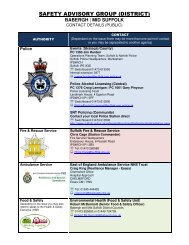Campylobacter Infection This leaflet is to tell you about ...
Campylobacter Infection This leaflet is to tell you about ...
Campylobacter Infection This leaflet is to tell you about ...
Create successful ePaper yourself
Turn your PDF publications into a flip-book with our unique Google optimized e-Paper software.
<strong>Campylobacter</strong> <strong>Infection</strong><strong>Th<strong>is</strong></strong> <strong>leaflet</strong> <strong>is</strong> <strong>to</strong> <strong>tell</strong> <strong>you</strong> <strong>about</strong> <strong>Campylobacter</strong> infection. Although th<strong>is</strong> illness usually doesn't causeany long term problems, it <strong>is</strong> an unpleasant condition while it lasts.Now read on…………What <strong>is</strong> <strong>Campylobacter</strong>ios<strong>is</strong> and how common <strong>is</strong> it?<strong>Campylobacter</strong>ios<strong>is</strong> <strong>is</strong> an illness which causes diarrhoea that <strong>is</strong> caused by bacteria (germs) called<strong>Campylobacter</strong>. It <strong>is</strong> the commonest bacterial cause of diarrhoea in the United Kingdom and it <strong>is</strong>likely that many other cases are undiagnosed or are not reported. Virtually all cases occur as<strong>is</strong>olated events and not as a part of any large outbreaks.The condition occurs much more frequently in the summer months than in the winter. It <strong>is</strong> foundmore often in infants and <strong>you</strong>ng adults than in other age groups and in males more often thanfemales.How <strong>is</strong> campylobacterios<strong>is</strong> caught?Most cases of <strong>Campylobacter</strong>ios<strong>is</strong> ar<strong>is</strong>e from handling raw poultry or eating undercooked poultrymeat. It can also be caught from contaminated water and milk, where cases have been linked <strong>to</strong> birdpecking of bottle <strong>to</strong>ps.A very small number of germs are needed <strong>to</strong> cause illness in humans - just one drop of juice fromraw chicken meat, for instance.A common way of becoming infected <strong>is</strong> <strong>to</strong> cut raw poultry meat on a cutting board and then use theunwashed or lightly rinsed board <strong>to</strong> prepare foods such as salad vegetables or cold meats. Becausethese foods do not need cooking, any contamination from the chicken can survive and be passed on.The germ <strong>is</strong> not usually spread from person <strong>to</strong> person unless the infected person <strong>is</strong> a small child or<strong>is</strong> producing a large amount of diarrhoea.Some people become ill through contact with an ill dog or cat.How does <strong>Campylobacter</strong> get in<strong>to</strong> food?Many chicken flocks have birds that contain <strong>Campylobacter</strong> within their intestines but whichproduce no symp<strong>to</strong>ms of any illness. Estimates vary but more than half of the raw chicken on salewithin the U.K. <strong>is</strong> thought <strong>to</strong> have <strong>Campylobacter</strong> on it. The germ <strong>is</strong> also present in giblets,especially on the liver.Unpasteur<strong>is</strong>ed milk can become contaminated if the cow has a <strong>Campylobacter</strong> infection or if themilk <strong>is</strong> contaminated with manure. Because so few germs are needed <strong>to</strong> cause illness, it <strong>is</strong> verydifficult <strong>to</strong> prevent contamination, even with the best dairy hygiene standards.Surface waters and mountain streams can become contaminated with infected faeces from cattle orwild birds.
What are the symp<strong>to</strong>ms of <strong>Campylobacter</strong>ios<strong>is</strong>?Most people with th<strong>is</strong> illness develop diarrhoea, abdominal pain and sometimes fever within 2 <strong>to</strong> 5days of becoming infected. In some cases it can take up <strong>to</strong> 11 days for symp<strong>to</strong>ms <strong>to</strong> start and forothers they may develop no symp<strong>to</strong>ms at all. The diarrhoea may be bloody and can be accompaniedby nausea and vomiting. Abdominal pain may pers<strong>is</strong>t for several days after other symp<strong>to</strong>ms subside.In persons with reduced immunity such as the very infirm or those who are on special medialtreatment, the illness can occasionally spread <strong>to</strong> the bloodstream and cause a very serious illness.Are there any long term complications of <strong>Campylobacter</strong>ios<strong>is</strong>?Most people who have th<strong>is</strong> illness recover completely within two <strong>to</strong> five days although sometimes itcan take a few days longer.Arthrit<strong>is</strong> and other serious long term effects are possible but these happen very rarely.How do <strong>you</strong> know if <strong>you</strong> have <strong>Campylobacter</strong>ios<strong>is</strong>?Many different kinds of infections can cause diarrhoea and bloody diarrhoea. <strong>Campylobacter</strong>ios<strong>is</strong>can only be diagnosed by growing the germ from a s<strong>to</strong>ol sample in a labora<strong>to</strong>ry.How <strong>is</strong> <strong>Campylobacter</strong>ios<strong>is</strong> treated?Virtually all persons infected with <strong>Campylobacter</strong> will recover without any specific treatment. Theyshould drink plenty of fluids as long as the diarrhoea lasts.In more severe cases, antibiotics can be used and can shorten the duration of symp<strong>to</strong>ms if they aregiven early in the illness.What can I do <strong>to</strong> prevent <strong>Campylobacter</strong>ios<strong>is</strong>? What can I do if I have it?There <strong>is</strong> no vaccine against campylobacter nor do <strong>you</strong> become immune <strong>to</strong> it, so it <strong>is</strong> important <strong>to</strong>prevent it spreading and <strong>to</strong> avoid infection as far as possible.• Cook all poultry products thoroughly. Make sure that the meat <strong>is</strong> cooked throughout and thatany juices run clear. If <strong>you</strong> are served undercooked poultry in a restaurant, do not eat it andcomplain <strong>to</strong> the manager and <strong>to</strong> <strong>you</strong>r local Environmental Health Department.• Wash <strong>you</strong>r hands with soap and hot water before and after handling raw meats.• Avoid cross-contamination of foods - remember how few germs are needed <strong>to</strong> cause illness• Carefully clean all cutting boards, work surfaces and utensils with detergent and hot water afterpreparing raw meats. Use separate chopping boards for raw and ready-<strong>to</strong>-eat foods whereverpossible.• Avoid consuming unpasteur<strong>is</strong>ed milk or water that may be polluted. The clear hillside streammay be tempting on a hot summer's day but looks can be deceptive.
• If <strong>you</strong> have the illness and work with children or the elderly, or work in a hospital or a foodbusiness, adv<strong>is</strong>e <strong>you</strong>r superv<strong>is</strong>or. Your local Environmental Health Department, who caninvestigate <strong>to</strong> try and prevent further cases, may contact <strong>you</strong>.• <strong>Campylobacter</strong> germs stay in <strong>you</strong>r system for several days after symp<strong>to</strong>ms s<strong>to</strong>p, so it <strong>is</strong>important <strong>to</strong> maintain a very high level of personal hygiene during th<strong>is</strong> time.Small print <strong>about</strong> <strong>Campylobacter</strong> (Optional)The <strong>Campylobacter</strong> germ <strong>is</strong> actually a group of bacteria that cause illness in humans and animals.99% of human illness <strong>is</strong> caused by one species, <strong>Campylobacter</strong> jejuni, which grows best at the bodytemperature of a bird. It seems well adapted <strong>to</strong> birds, who have it without becoming ill.It <strong>is</strong> very fragile and easily killed by drying. Freezing greatly reduces its numbers and it does notgrow on food once it <strong>is</strong> contaminated.It <strong>is</strong> not clear why it <strong>is</strong> so rarely spread from person <strong>to</strong> person when the numbers required <strong>to</strong> causeillness <strong>is</strong> so small.Produced by the Suffolk Health Authority and Suffolk Local Authorities working in partnershipSuffolk Health, St Edmundsbury B.C, Suffolk Coastal D.C, Babergh D.C, Forest Heath D.C, Ipswich B.C, Mid-Sufffolk D.C and Waveney D.C.
















